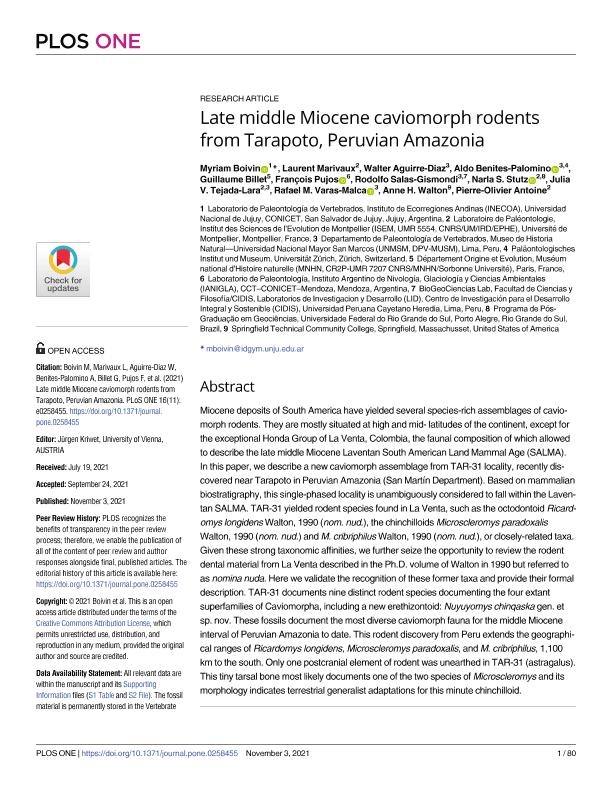Artículo
Late middle Miocene caviomorph rodents from Tarapoto, Peruvian Amazonia
Boivin, Myriam ; Marivaux, Laurent; Aguirre Diaz, Walter; Benites Palomino, Aldo; Billet, Guillaume; Pujos, François Roger Francis
; Marivaux, Laurent; Aguirre Diaz, Walter; Benites Palomino, Aldo; Billet, Guillaume; Pujos, François Roger Francis ; Salas Gismondi, Rodolfo; Stutz, Narla; Tejada Lara, Julia V.; Varas Malca, Rafael; Walton, Anne H.; Antoine, Pierre Olivier
; Salas Gismondi, Rodolfo; Stutz, Narla; Tejada Lara, Julia V.; Varas Malca, Rafael; Walton, Anne H.; Antoine, Pierre Olivier
 ; Marivaux, Laurent; Aguirre Diaz, Walter; Benites Palomino, Aldo; Billet, Guillaume; Pujos, François Roger Francis
; Marivaux, Laurent; Aguirre Diaz, Walter; Benites Palomino, Aldo; Billet, Guillaume; Pujos, François Roger Francis ; Salas Gismondi, Rodolfo; Stutz, Narla; Tejada Lara, Julia V.; Varas Malca, Rafael; Walton, Anne H.; Antoine, Pierre Olivier
; Salas Gismondi, Rodolfo; Stutz, Narla; Tejada Lara, Julia V.; Varas Malca, Rafael; Walton, Anne H.; Antoine, Pierre Olivier
Fecha de publicación:
11/2021
Editorial:
Public Library of Science
Revista:
Plos One
ISSN:
1932-6203
Idioma:
Inglés
Tipo de recurso:
Artículo publicado
Clasificación temática:
Resumen
Miocene deposits of South America have yielded several species-rich assemblages of caviomorph rodents. They are mostly situated at high and mid- latitudes of the continent, except for the exceptional Honda Group of La Venta, Colombia, the faunal composition of which allowed to describe the late middle Miocene Laventan South American Land Mammal Age (SALMA). In this paper, we describe a new caviomorph assemblage from TAR-31 locality, recently discovered near Tarapoto in Peruvian Amazonia (San Martín Department). Based on mammalian biostratigraphy, this single-phased locality is unambiguously considered to fall within the Laventan SALMA. TAR-31 yielded rodent species found in La Venta, such as the octodontoid Ricardomys longidens Walton, 1990 (nom. nud.), the chinchilloids Microscleromys paradoxalis Walton, 1990 (nom. nud.) and M. cribriphilus Walton, 1990 (nom. nud.), or closely-related taxa. Given these strong taxonomic affinities, we further seize the opportunity to review the rodent dental material from La Venta described in the Ph.D. volume of Walton in 1990 but referred to as nomina nuda. Here we validate the recognition of these former taxa and provide their formal description. TAR-31 documents nine distinct rodent species documenting the four extant superfamilies of Caviomorpha, including a new erethizontoid: Nuyuyomys chinqaska gen. et sp. nov. These fossils document the most diverse caviomorph fauna for the middle Miocene interval of Peruvian Amazonia to date. This rodent discovery from Peru extends the geographical ranges of Ricardomys longidens, Microscleromys paradoxalis, and M. cribriphilus, 1,100 km to the south. Only one postcranial element of rodent was unearthed in TAR-31 (astragalus). This tiny tarsal bone most likely documents one of the two species of Microscleromys and its morphology indicates terrestrial generalist adaptations for this minute chinchilloid.
Palabras clave:
RODENTIA
,
CAVIOMORPHA
,
AMAZONIA
,
MIOCENE
Archivos asociados
Licencia
Identificadores
Colecciones
Articulos(IANIGLA)
Articulos de INST. ARG. DE NIVOLOGIA, GLACIOLOGIA Y CS. AMBIENT
Articulos de INST. ARG. DE NIVOLOGIA, GLACIOLOGIA Y CS. AMBIENT
Articulos(INECOA)
Articulos de INSTITUTO DE ECORREGIONES ANDINAS
Articulos de INSTITUTO DE ECORREGIONES ANDINAS
Citación
Boivin, Myriam; Marivaux, Laurent; Aguirre Diaz, Walter; Benites Palomino, Aldo; Billet, Guillaume; et al.; Late middle Miocene caviomorph rodents from Tarapoto, Peruvian Amazonia; Public Library of Science; Plos One; 16; 11; 11-2021; 1-80
Compartir
Altmétricas



